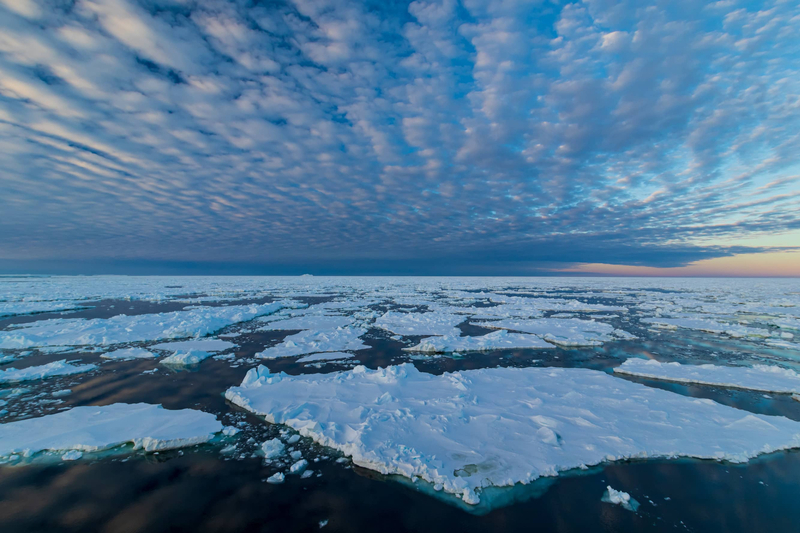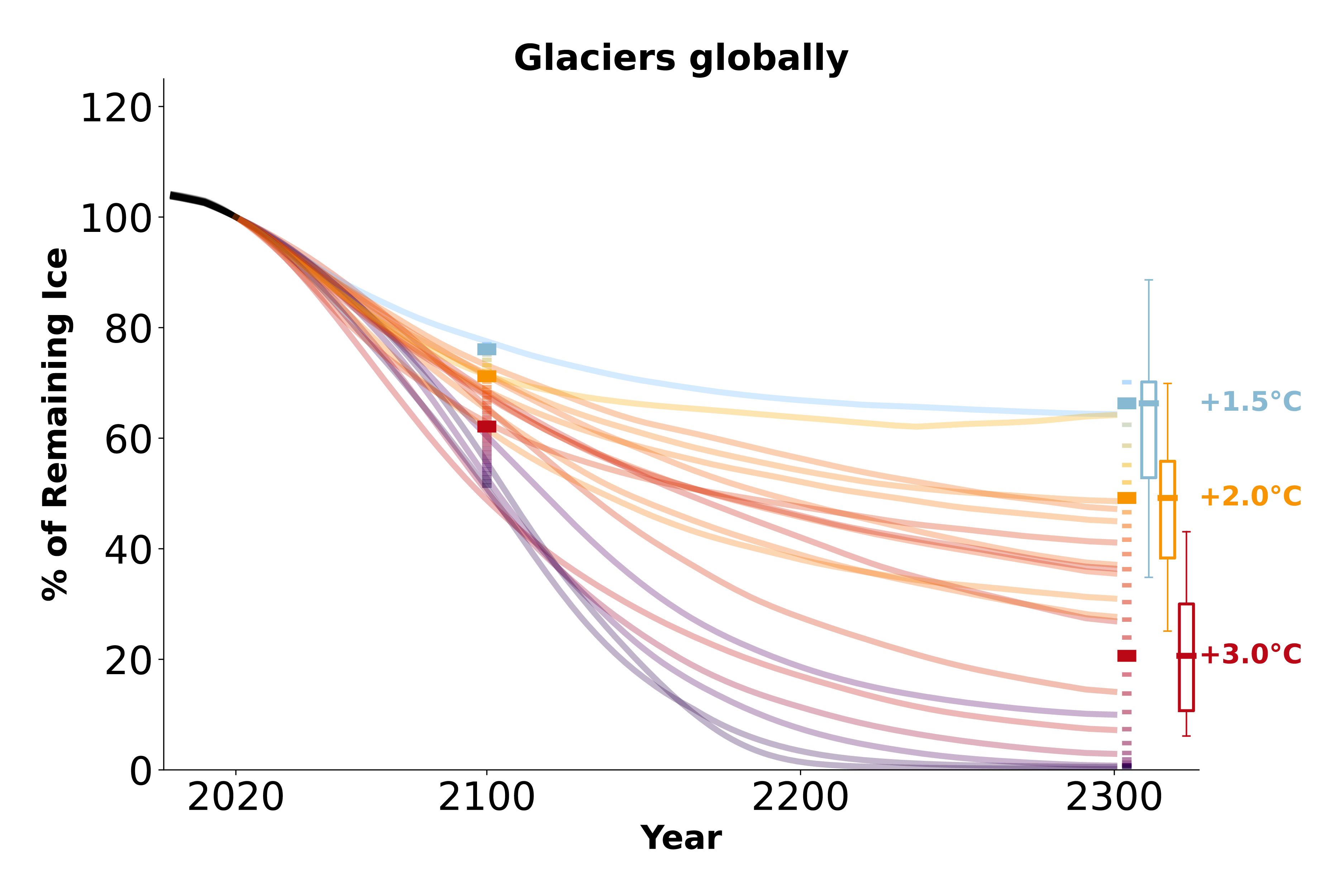The International Cryosphere Climate Initiative (ICCI) today published its annual State of the Cryosphere Report which warns that even 2°C – the “upper” Paris Agreement temperature limit – will lead to catastrophic global damage from loss of ice sheets, mountain glaciers and snow, sea ice, permafrost, and in polar oceans. The MRI was pleased to contribute to Chapter 3: Mountain Glaciers and Snow.
The State of the Cryosphere 2023 – Two Degrees is Too High takes the pulse of the cryosphere by updating the latest science and highlighting the global impacts from changes in the cryosphere.
Reviewed and supported by over 60 leading cryosphere scientists, the report shows that all of the Earth’s frozen parts will experience irreversible damage at 2°C of global warming, with disastrous consequences for millions of people, societies, and nature.
Key findings in the report on the impact of 2°C of warming include:
- Ice sheets: nearly all of Greenland, much of West Antarctica, and even vulnerable portions of East Antarctica will be triggered to very long-term, inexorable sea-level rise.
- Glaciers: extensive, irreversible ice loss from the world’s glaciers in many major river basins, with some disappearing entirely. As glaciers melt, risks of catastrophic events such as landslides, sudden ice shears, and glacial lake outburst floods increase.
- Sea ice: extensive sea ice loss at both poles, with severe feedbacks to global weather and climate. By 2°C, the Arctic Ocean will be sea ice-free in summer every year, potentially for several months.
- Permafrost: extensive permafrost thaw and resulting greenhouse gas emissions will cause temperatures to continue to rise, even once human emissions reach zero. At 2°C, annual total permafrost emissions (both CO2 and methane) would total the size of the entire European Union’s emissions from 2019.
- Polar ocean acidification: year-round, permanent corrosive ocean acidification conditions in many regions of Earth’s polar and near-polar seas. Shell-building animals, and commercial fisheries that rely on them in the food chain may not survive.
In response to the Report, Katrín Jakobsdóttir, Prime Minister, Iceland, said: “From the Cryosphere point of view, 1.5°C is not simply preferable to 2°C or higher. It is the only option. At COP28, we need a frank Global Stocktake, and fresh urgency especially due to what we have learned about Cryosphere feedbacks, worsening for each additional tenth of a degree in temperature rise. We need tangible results, and clear guidelines to phase out fossil fuels and for financial mechanisms to finance climate action.”
Professor Julie Brigham-Grette, University of Massachusetts Amherst, said: “Our message is that this insanity cannot and must not continue. COP28, and December 2023, must be when we correct course. Otherwise, world leaders are de facto deciding to burden humanity for centuries to millennia by displacing hundreds of millions of people from flooding coastal settlements; depriving societies of life-giving freshwater resources, disrupting delicately-balanced polar ocean ecosystems; and forcing future generations to offset long-term permafrost emissions.”
Dr. Pema Gyamtsho, Director General, International Centre for Integrated Mountain Development (ICIMOD), said: “The Hindu Kush Himalaya is at the epicentre of the global cryosphere crisis with our glaciers, snow, and permafrost already undergoing unprecedented and irreversible changes. These changes are upending the lives of mountain communities by increasing uncertainty in the timing, availability, and seasonal distribution of mountain water resources, threatening water, food, and energy security. The State of the Cryosphere Report is a warning to global leaders that inaction at COP28 will be disastrous.”
Figure 3-2: Colors Show Global Temperature Change in 2100, Without Overshoot, by Tenths of a Degree
1.4°–4.5°C Glaciers worldwide are losing ice at today’s 1.2°C. Should current emissions continue, meaning global temperatures reach 4.5°C by 2100, this loss will become quite rapid even for the largest glaciers near the poles that make up most of this all-glacier graph; reaching 50% worldwide glacier loss by 2100 and no glaciers globally by 2200. CREDIT: SCHUSTER ET AL. (2023)
The publication of the State of the Cryosphere Report comes at a critical time before the UNFCCC Conference of Parties (COP28) which is taking place in Dubai from 30 November 2023 - 12 December 2023. The Report’s Foreword calls on global leaders to enshrine the commitment to “1.5°C alone” in the Cover Decision because 2°C is too high for the cryosphere. Cryosphere scientists last week launched “Call for the Cryosphere”, a parallel global campaign, at the One Planet Polar Summit in Paris. The “Call” urges global leaders to agree on guidelines to make 1.5°C a reality; a path to phase out fossil fuels; and financial mechanisms to support climate action; as well as the adaptation to, and loss and damage from, climate change.
“2023 has been a year of climate disasters and ice loss, which has underlined the urgent need for global leaders to recognise that two degrees is too high for Earth’s cryosphere,” concluded Pam Pearson, Director of ICCI. “Today’s landmark report shows that we need to take 2°C off the table.”
Mountain Glaciers and Snow: 2023 Updates
- Improved projections forecast greater glacier loss by 2100, including total or near-total glacier loss in mid- and low latitudes by 2100 under a high emission scenario, as well as up to 80% glacier loss in the Hindu Kush Himalaya.
- New research suggests that glaciers can now produce floods even at the highest elevations, which were previously stabilized by snowfall and cooler temperatures.
- One study found that an estimated fifteen million people worldwide are now at risk from glacier lake outburst floods, with most residing in High Mountain Asia and Peru.
- New research highlights growing threats to hydro-power in High Mountain Asia due to declining mountain glaciers and thawing mountain permafrost.
- Numerous new studies have identified increasing decline of mountain snowpack with significant impacts on hazard risk, water supplies,35 and food security, including via global trade.
- Snowpack across the Arctic and near-Arctic, especially in northern Canada and Alaska, melted far earlier than normal, leaving ground bare for longer. Meteorologists attribute some of the record North American summer 2023 heatwaves to this record melt.
- Glaciers in the Swiss Alps lost 10% of their ice in the two years 2022–23, reported the Swiss glacier monitoring agency GLAMOS. These losses were attributed especially to heat waves, which are expected to intensify as time goes on.
- What may have been the most extreme heatwave on the planet in 2023 occurred in the Andes during the southern hemisphere winter, with temperatures up to 20°C above normal for several weeks, leading to concerns for water shortages due to decreased snow-pack, especially in Chile, Argentina and Paraguay.
- New research underscores that threats to eco-systems are dramatically growing with loss of the mountain cryosphere, with decline and extinction already observed today.
- The IPCC AR6 Synthesis Report reiterates the urgency of keeping global average temperature rise below 1.5°C to avoid the most serious consequences and hard adaptation limits for many generations in high mountain and downstream areas.

Figure 3-5: Two Record Years of Ice Loss
Height of glacier ice loss at Konkordiaplatz, Switzerland, during record melt years 2022 and 2023 compared to the average yearly ice loss between 1950–1980. The Swiss Alps as a whole lost 10% of their remaining ice in just two summers. PHOTO: MATTHIAS HUSS
Sign the Cryosphere Call to Action – COP28: 2°C is Too High
About the State of the Cryosphere Report 2023
Reviewed and supported by over 60 leading cryosphere scientists, this is the latest report in the State of the Cryosphere series, which takes the pulse of the cryosphere on an annual basis. The cryosphere is the name given to Earth’s snow and ice regions and ranges from ice sheets, glaciers, snow and permafrost to sea ice and the polar oceans – which are acidifying far more rapidly than warmer waters. The Report describes how a combination of melting polar ice sheets, vanishing glaciers, and thawing permafrost will have rapid, irreversible, and disastrous impacts worldwide.
Cover image by James Kirkham, courtesy of the International Cryosphere Climate Initiative.








